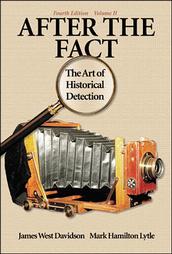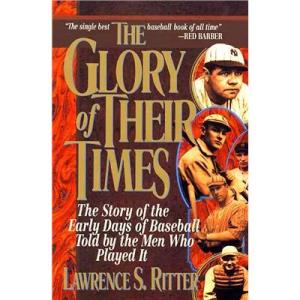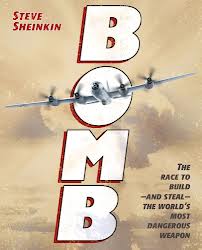Mom,
Thanks for the thoughts on The Opposite of Hallelujah. Unfortunately, I haven’t read it, so I don’t have anything to add, but I will keep my eye out for it (I believe I just ordered a copy for my branch).
 I want to change gears a little and talk about history, which I have been thinking about a lot recently. This started (more or less) with my re-reading of one of the great pieces of historiography around, After the Fact: The Art of Historical Detection by James Davidson and Mark Lytle. As you know, I read this book first in my Junior year of High School, in Fr. Clemo’s AP US History class. I knew at the time that it was something special, but the pressures of the year didn’t allow me to fully appreciate it. Coming back to it almost 15 years later was quite a revelation. You’ve read the book too (in fact, if I remember correctly, you read it along with me to help me study for that class), but for the benefit of our readers, the purpose of their book is to show that history is not simply “what happened in the past.” Instead, in Davidson and Lytle’s view, history is an active process of selecting evidence, analyzing documents, using a variety of political theories, and more. The purpose of a good historical work, then, is not to simply convey the exact facts of everything that happened in the past, but to provide a framework and theory for understanding how and why those things happened. In the course of making this argument, Davidson and Lytle examine a number of events from American history through the lens of various theories and modes of analyzing to show how different ways of “doing history” lead to different interpretations. It’s really just staggeringly good, and I think essential reading for anyone who wants to critique works of history.
I want to change gears a little and talk about history, which I have been thinking about a lot recently. This started (more or less) with my re-reading of one of the great pieces of historiography around, After the Fact: The Art of Historical Detection by James Davidson and Mark Lytle. As you know, I read this book first in my Junior year of High School, in Fr. Clemo’s AP US History class. I knew at the time that it was something special, but the pressures of the year didn’t allow me to fully appreciate it. Coming back to it almost 15 years later was quite a revelation. You’ve read the book too (in fact, if I remember correctly, you read it along with me to help me study for that class), but for the benefit of our readers, the purpose of their book is to show that history is not simply “what happened in the past.” Instead, in Davidson and Lytle’s view, history is an active process of selecting evidence, analyzing documents, using a variety of political theories, and more. The purpose of a good historical work, then, is not to simply convey the exact facts of everything that happened in the past, but to provide a framework and theory for understanding how and why those things happened. In the course of making this argument, Davidson and Lytle examine a number of events from American history through the lens of various theories and modes of analyzing to show how different ways of “doing history” lead to different interpretations. It’s really just staggeringly good, and I think essential reading for anyone who wants to critique works of history.
Let me start with a fairly straightforward example, a book you just gave me  this weekend: The Glory of Their Times, by Lawrence Ritter. Despite the title page, Ritter didn’t actually write this book at all. Rather, it is a collection of transcriptions of old baseball players talking about their playing years (originally published in 1966). So, by all appearances, what we have here is a straightforward piece of primary source history: participants in the events, discussing the events. But it’s actually more tricky than that, as Davidson and Lytle point out in a chapter about the New Deal project to record the reminiscences of former slaves. Because in a source like The Glory of Their Times, we have to take into account at least two important pieces of information: 1) the fact that Ritter edited the accounts, trimming them to fit into a book, rearranging some words, deleting his own questions, and organizing all of the accounts into a single book in a particular order; and possibly more importantly (and much less transparently) 2) the fact that Ritter was involved in the work at all. Because, after all, Ritter was the one who went and tracked down these ballplayers, asked them particular questions in a particular order, recorded them, etc. So we have to ask what kind of biases exist in the account that might have been brought on by Ritter’s involvement. Davidson and Lytle show how the same former slave gave two completely different accounts of his slave days to a white and a black interviewer. In Ritter’s case, it is less pernicious. Nevertheless, we know from reading his introduction that he is a firm believer in “the good old days” of baseball, so we should be very wary when we start reading ballplayer after ballplayer express the exact same view that Ritter does in the introduction. Since we don’t even have his questions, we don’t know if they were leading ones, or if just his general attitude played a role in how these men told their stories.
this weekend: The Glory of Their Times, by Lawrence Ritter. Despite the title page, Ritter didn’t actually write this book at all. Rather, it is a collection of transcriptions of old baseball players talking about their playing years (originally published in 1966). So, by all appearances, what we have here is a straightforward piece of primary source history: participants in the events, discussing the events. But it’s actually more tricky than that, as Davidson and Lytle point out in a chapter about the New Deal project to record the reminiscences of former slaves. Because in a source like The Glory of Their Times, we have to take into account at least two important pieces of information: 1) the fact that Ritter edited the accounts, trimming them to fit into a book, rearranging some words, deleting his own questions, and organizing all of the accounts into a single book in a particular order; and possibly more importantly (and much less transparently) 2) the fact that Ritter was involved in the work at all. Because, after all, Ritter was the one who went and tracked down these ballplayers, asked them particular questions in a particular order, recorded them, etc. So we have to ask what kind of biases exist in the account that might have been brought on by Ritter’s involvement. Davidson and Lytle show how the same former slave gave two completely different accounts of his slave days to a white and a black interviewer. In Ritter’s case, it is less pernicious. Nevertheless, we know from reading his introduction that he is a firm believer in “the good old days” of baseball, so we should be very wary when we start reading ballplayer after ballplayer express the exact same view that Ritter does in the introduction. Since we don’t even have his questions, we don’t know if they were leading ones, or if just his general attitude played a role in how these men told their stories.
 OK, I think you get the point. Let’s get to a book that is much more on people’s minds today: Bomb by Steve Sheinkin. As you know, there is a tremendous debate going on right now (or it might be over by now) on Heavy Medal, about Bomb‘s merits as a piece of history (no one, I think, disputes its merits as a top-notch piece of literature). There are various pieces to the argument, but three primary ones are:
OK, I think you get the point. Let’s get to a book that is much more on people’s minds today: Bomb by Steve Sheinkin. As you know, there is a tremendous debate going on right now (or it might be over by now) on Heavy Medal, about Bomb‘s merits as a piece of history (no one, I think, disputes its merits as a top-notch piece of literature). There are various pieces to the argument, but three primary ones are:
1) Poor sourcing. Sheinkin’s source notes leave a number of things to be desired and it is often difficult to tell where a particular piece of information came from.
2) Inventing “gestures.” Sheinkin has his “characters” act as they would in a novel–sighing, banging fists, etc.–when (at least as far as we can tell at this point in the debate) the sources from which he is working provide only general outlines of conversations and interactions are known.
3) Possibly exaggerating the importance of events. Again, the jury appears to be out, but there seems to be some dispute as to how much importance Sheinkin places on the actions of the Norwegian saboteurs, whose actions take up something like a quarter of the book.
What I want to suggest is that while these criticisms may or may not be valid, the best way of approaching them is through Davidson and Lytle’s lens of “doing history.” Rather than having a Platonic ideal of what a “good history” is, we need to determine what model or models of historical work Sheinkin is using.
The first objection I’ve listed is fascinating, because it is one that Davidson and Lytle address specifically in their final chapter, in which they examine Woodward and Berstein’s The Final Days. As I’m sure you know, Woodward and Bernstein have been repeatedly criticized for their non-existent sourcing methods. Most of the information they collected was obtained off-the-record and therefore they felt that they could not provide readers with the true sources of the material. Many historians have been very unkind to Woodward and Bernstein for these methods, but Davidson and Lytle actually let them off the hook a bit. They show how a careful reading of the book actually makes it pretty obvious where almost all of the sourcing of the book comes from, and moreso, they point out that Woodward and Bernstein are engaged in a somewhat different model of history than their critics seem to want, one that owes much more to their journalism backgrounds than to historians. Now, this isn’t precisely the same objection as is being made of Bomb (since Sheinkin is using secondary sources, and there is no reason for him to hide his sources), but the point remains that while he could have been more transparent, a little legwork will generally lead the reader to the correct source. And, perhaps more interesting, even though he is writing about events from 60 and 70 years ago, he is very much writing in the same “journalistic” or “novelistic” style as Woodward and Bernstein.
Which brings us to the second point. I examined the second objection a little in a comment I made on the above linked blog post, when I compared Bomb to Von Drehle’s Triangle: The Fire That Changed America. I found that many of the “gesture” issues people had with Bomb were present in Von Drehle’s work as well, and I asked whether this was perhaps simply a new (or not so new) mode of telling history, in which a historian can be forgiven for adding little novelistic flourishes as long as the important facts and interpretations are right. I would like to do more research on this question (as to whether this is a general trend in popular historical writing), but even if it is not, it is important to understand that it is Sheinkin’s model–he is not trying to deceive his readers, merely to give them a good show. Should that change the way we see the book? Sure. Should it make it an illegitimate piece of history? That’s a more complicated question.
Finally, the third question of the importance of the Norwegian saboteurs. This is perhaps the most interesting of all, because here we an obvious example of Sheinkin’s interpretative method. The question that is being asked is: does Sheinkin’s book give too much credit to the Norwegian destruction of the German heavy water production for impeding the production of a German atomic bomb? And the answer is: it depends. From what I understand from other works I’ve read, it is at least possible to argue that the Germans would never have been able to build an atomic bomb before the end of the war, simply because of the dwindling supply lines. But as we’ve seen above, Sheinkin’s interpretative model is not a post facto analysis of the events of the war (in fact, one of the things that many, myself included, have praised him for is his nonjudgemental attitude towards the words and actions of his characters, an attitude that spreads out to a refusal to judge–unti the last page–even basic questions like “was it worth it to build and deploy an atomic bomb?”). Instead he is writing from an explicitly journalistic viewpoint, using the words of the participants at the time of the events as much as possible. For the American scientists he quotes, the Norwegian mission seemed absolutely crucial. The whole point of the American project was that ex-patriated German scientists were convinced that the Nazis were going to build a bomb. So, from this model, it is obvious that any and all attempts to delay the German bomb were necessary and heroic. If readers are looking for an after the fact evaluation of the importance of any of the book’s events, they should look elsewhere. We get no real sense of why the bomb was dropped on Hiroshima and Nagasaki, the reprecussions for the Cold War, the ways in which the Manhattan Project affected other scientific advances both during and after the war, and much more. So why should we expect an analysis of the true benefit of the Norwegian escapades?
Again, none of this is to say that Bomb should not be criticized. It certainly can be. For one thing, we could ask why Sheinkin chose the interpretative models he chose, and if perhaps it would have been better to offer more analysis of Allied decisions and less Great Man Theory. But without acknowledging that there is in fact a model, or set of models, that he is using, the argument will inevitably end up as two or more sides with different ideas of how history should be done, all talking past each other.
– Mark

Thanks for going into BOMB in more depth Mark! This is really helpful.
I have to clarify that by making my main argument (#2 here), I’m not suggesting that this model makes the book “an illegitimate piece of history.” I’m questioning whether this is the BEST approach for his audience.
And, re audience…Woodward and Bernstein weren’t writing for kids.
I posed my questions because I need a thoughtful grounding/response, and am open to being swayed. It’s just that I keep getting arguments back to a point I wasn’t quite making….
Thanks Nina – I moved this discussion over here precisely because I didn’t want to make it seem like I was picking on you. I totally understand your complaint, and I think it is a completely valid perspective on the book.
“illegitimate” was perhaps the wrong word to use, but it is entirely my own – I certainly didn’t mean to suggest that it was one that you were using against the book.
As for Woodward and Bernstein and audience, my personal instinct is that the vast majority of readers (children, teen, and adult all, but particularly children) are never going to go into the back matter to actually track down citations. I still think it is very important to have the back matter, and for it to be as transparent as possible, but I think for the most part it is adults who will be using that back matter to determine whether or not the book stands up to scholarly scrutiny. Now – I don’t know how that argument flies with the Newbery Criteria, but that’s another reason for discussing this over here, where I’m not limited the criteria.
Finally, I totally understand your frustration on “getting arguments back to a point I wasn’t quite making”, and while I myself have probably been guilty of contributing to that, I hope that this post is at least a little helpful not so much for my specific comments about Triangle, etc. which I’ve already made on Heavy Medal, but for the concept of historiographical models. I really think we have to have some sort of basic agreement about what type of nonfiction models we are looking at and judging based on before we are going to be able to come to a consensus about how well or poorly Sheinkin uses those models.
Thanks Mark. I’m a bit of a bulldog on this, but you have every right to set a your own context here. 😉 I think discussion here will help inform later discussion back at Heavy Medal. Thanks for keeping it going.
Pingback: Lincoln’s Grave Robbers | crossreferencing